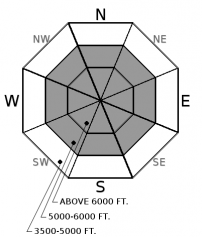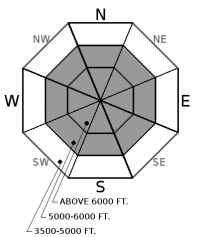| Saturday | Saturday Night | Sunday | |
|---|---|---|---|
| Cloud Cover: | Scattered mountain snow showers | Mostly Cloudy | Scattered mountain snow showers |
| Temperatures: | 38 to 43 deg. F. | 25 to 30 deg. F. | 40 to 45 deg. F. |
| Wind Direction: | SW | SW | S |
| Wind Speed: | 10 to 15 mph, gusts 20 mph | 5 to 10 mph, gusts 15 mph | 5 to 10 mph |
| Snowfall: | 0 in. | 0 in. | 0 in. |
| Snow Line: |
Whitefish Range
Swan Range
Flathead Range and Glacier National Park
How to read the forecast
Several storm slabs were easily triggered in the new snow on Friday. Up to 20” of new snow is consolidating into reactive slabs over a variety of crusts and will slowly bond with old snow through the weekend. Cracks in the snow surface are a sign of instability to avoid steep terrain. Periods of sunshine on Saturday and warmer temperatures on Sunday will increase the threat of loose wet avalanches. Monitor surface warming.

No Rating
?
Above 6500 ft.
No Rating
?
5000-6500 ft.
No Rating
?
3500-5000 ft.
-
Type ?
-
Aspect/Elevation ?

-
Likelihood ?CertainVery LikelyLikelyPossible
 Unlikely
Unlikely -
Size ?HistoricVery LargeLargeSmall

Snowfall over the past 48 hours ranged from 8-21” and 1.0-2.9” SWE throughout the forecast area, with the Swans receiving the deepest amounts and largest load. Storm slabs formed over a variety of crust and a wind-stiffened surface which will act as a slipper bed surface. Yesterday, my partner and I were able to trigger 12” storm slabs on steep, convex terrain features at mid and upper elevations in GNP. These slabs were running on a buried crust, moving fast, and entraining snow as they moved downslope. Warmer temps on Saturday will promote settlement and stiffening of these slabs. Storm slabs are likely to be triggered on Saturday but trending towards possible on Sunday as they gain strength. Surface instabilities can be evaluated by using quick pits and small test slopes to evaluate new snow bonding. Anticipate deeper drifts on convex or cross-loaded terrain on leeward slopes. Cracks in the snow surface is a sign of instability.
-
Type ?
-
Aspect/Elevation ?

-
Likelihood ?CertainVery LikelyLikelyPossible
 Unlikely
Unlikely -
Size ?HistoricVery LargeLargeSmall

New snow and warming temps are ideal ingredients for loose wet avalanches. The weather forecast is calling for periods of sunshine Saturday afternoon with temps near 6000 ft approaching freezing. Combination of warm temps and sunshine could moisten the snow surface and quickly increase the potential for wet sluffs. Sunday’s temps are forecasted to be even warmer than Saturday and could increase the distribution of loose wet avalanches into upper elevations. Pinwheels or rollerballs are signs of decreasing stability and suggest its time to move to colder snow or lower angled slopes. These slides are most dangerous in long-running gullies or above cliffs.
March madness for college basketball might have ended at the end of March, but snowfall madness continues into April for northwest Montana. Snowfall over the past 48 hours ranged from 8-21” and 1.0-2.9” SWE throughout the forecast area, with the Swans receiving the deepest amounts and largest load. Yesterday, I found reactive storm slabs at mid and upper elevations running on buried crust formed earlier this week. Rain or melt-freeze crust below storm slabs act as a slippery bed surface allowing them to run fast and far while entraining all the snow above the old snow surface. Warm temps on Saturday and Sunday will promote settlement and stiffening of these slabs but could potentially make them more widespread. These slabs will slowly gain strength over the weekend but their sensitivity to the weight of a skier or rider should be evaluated before committing to bigger slopes. I anticipate that on Saturday, it remains likely to trigger a storm slab but trending towards possible for Sunday. Use quick pits and small test slopes to evaluate bonding with the old snow surface.
The pattern of cold storms followed by warming temperatures and/or sunshine has initiated loose wet cycles all through April. There is always some uncertainty with forecasting for cloud cover and temperatures, but its easy to pay attention to signs of surface warming in the field. If temps approach freezing near 6000 ft, anticipate that the loose wet problem could extend into upper elevation slopes. Wet, dense snow and lower snow totals exist at lower elevations but loose wet slides running on a buried crust at mid-elevations could run far enough to enter our lower zones.
We decided to remove our persistent slab problem from our problem list. We have limited data on this problem and recent observations highlight this problem being confined to the eastern half of our forecast area near the Continental Divide. Multiple stability tests (ob 1, ob 2, ob 3) produced propagating results earlier in the week and we had a few natural avalanches that most likely failed on this layer. Dig down 2 to 3 ft to evaluate if this problem exists before committing to larger slopes. If stability is in question, use terrain selection as your answer by avoiding steep, convexities or unsupported slopes.
If you and your partners have assessed terrain as appropriate for the day’s conditions, apply a few simple travel strategies to reduce your risk. Sometimes we assess stability incorrectly and our safety protocols are the only thing separating a good story from a tragedy.
-Always carry a beacon, shovel, and probe. The odds of a successful companion rescue are limited without them.
-Provide adequate spacing between yourself and your partners as you pass through avalanche terrain. Your partner(s) can’t initiate a rescue if they are also buried. Multiple burials require more time and resources with the odds of surviving even lower.
-Keep your eyes on terrain above you and get out of harm’s way.
Zach will issue our final spring travel statement on Monday, April 16th.
A weak shortwave moves through northwest Montana Saturday with light accumulations throughout the forecast area. We could see a brief period of sunshine Saturday afternoon with mountain temps warming to near freezing at 6000 ft. Sunday will be even warmer than Saturday with daytime temps warming into the mid-40s at lower elevations and upper 30s at upper elevations. Winds remain generally light throughout the next 36 hours with occasional stronger gusts along upper elevation ridgelines. The next major weather producer is forecasted to arrive Sunday evening into Tuesday.
This advisory applies only to backcountry areas outside established ski area boundaries. This advisory describes general avalanche conditions and local variations always occur. This advisory expires at midnight on the posted day unless otherwise noted. The information in this advisory is provided by the USDA Forest Service who is solely responsible for its content.























